Header image courtesy of the Bay Area Reporter archives
When Wayne Justmann was diagnosed with HIV in 1988, he found himself at the mercy of experimental drugs that wreaked havoc on the body.
“We didn’t know what would kill us first, the virus or the drugs,” says Justmann. But luckily Justmann lived in San Francisco, where just about everyone in the city knew about Dennis Peron’s Cannabis Buyers Club, which offered plant medicine to patients living with HIV and other life-threatening illnesses. Fed up with draconian drug policies that prevented dying people from receiving desperately needed relief, Justmann came to the Cannabis Buyers Club ready to join Peron in his fight for legalization.
“Dennis and I started to smoke a joint, and he said: I think we can help one another.” And so Justmann entered the ranks of Peron’s ragtag army of queer and counterculture activists who would go on to win the battle to legalize medical cannabis.
Dennis Peron was a leading figure in San Francisco’s queer counterculture for decades, and he had cannabis to thank. According to the documentary series Cannabis Buyers Club, which debuted at the Tribeca Film Festival on June 16th, Peron first started sending cannabis back to the United States from Vietnam after his refusal to shoot civilians during the Tet Offensive got him moved to a job in the mail room. As soon as his return flight from Vietnam touched down in San Francisco, the “gay kid from Long Island who joined the Air Force to get away from home” knew he was home. Peron hit the ground running, establishing the first of his many legendary cannabis emporiums that epitomized San Francisco’s hippie heyday.
Though his cannabis businesses attracted plenty of police attention, he was known to be fearless before the authorities. In the film, his friends recall once being arrested for cannabis possession alongside Peron, who started passing joints around the back of the paddywagon. When the police told him to cut it out, Peron replied, “Or what? You’ll bust us?”
Peron would need such tenacity as the promise of the 60s gave way to the reactionary reprisals of the 1970s. When Richard Nixon blatantly used national drug policy to strike down political dissidents and minorities, Peron found himself targeted by the San Francisco police, who shot him in the leg during an undercover raid. As one of Nixon’s campaign advisors later said, “We knew we couldn’t make it illegal to be either against the war or black, but by getting the public to associate the hippies with marijuana and blacks with heroin, and then criminalizing both heavily, we could disrupt those communities.” Peron was serving a cannabis sentence when his friend and ally Harvey Milk, San Francisco’s most groundbreaking progressive gay politician, was assassinated in 1978 by a conservative political rival.
But even witnessing the bloody end of the revolution paled in comparison to what the gay community suffered when AIDS struck San Francisco. “People were dying and folks didn’t know what the hell was killing them,” says Justmann. In Cannabis Buyers Club, survivors wear the same haunted look on their faces as they recount the stories of vital young men aging decades seemingly overnight, growing frail, and wasting away. Even once the virus had been identified, finding a way to alleviate the symptoms took time. Cannabis was one of the few things known to help. Countless people reported that cannabis was often the only way to get an AIDS patient’s appetite back, no small thing considering some patients would lose up to forty pounds a month. An extra ten pounds gained through smoking before mealtimes could mean the difference between life and death. Those hit hardest by AIDS may have already been cannabis believers, but seeing it bring vitality and joy to a frightened and despairing gay community must have been like witnessing an act of divine intervention.
Peron and John Entwistle founded the Cannabis Buyers Club, a place where a death sentence could suddenly become a golden ticket to the coolest joint in San Francisco. In the five-story coffee house, people from all walks of life sprawled on couches and cushions rolling joints or toking from the hookahs scattered throughout the rooms. Music played, Brownie Mary passed around her legendary goodies, and the sick laughed and sat with the well—right under the nose of a paranoid, authoritarian society that treated HIV patients like lepers.
In the words of Lynette Shaw, who did intake at the Cannabis Buyers Club before becoming a full-time medical marijuana advocate, “You’d see a ray of life in all these terribly sick and suffering people when you gave them a bud.” Getting high brought back their will to live, and the Cannabis Buyers Club gave people a place to do their living, unencumbered by the weight of stigma and government indifference. “In the club there was hope—everybody would walk in with a smile on their face,” says Shaw. “You’d get your joint, sit on the couch and share it, talk and be around each other.”
Shaw was brought into the Buyers Club fold on the recommendation of Jack Herer, whom she met while he was spreading the gospel of plant medicine down in Southern California. “He gave me an autographed copy of his book,” she remembers. “Three days later, I wasn’t crazy, I was right. Pot was medicine and I was a prisoner of war.” Shaw had recently been busted, and her jail sentence was only a few months away. “I met with Jack in L.A., and he knew I was going to jail and was pissed,” she says with a chuckle. “He said, “I always get the best activists after they get busted. He sent me to Dennis Peron when AIDS hit the Castro hard.”
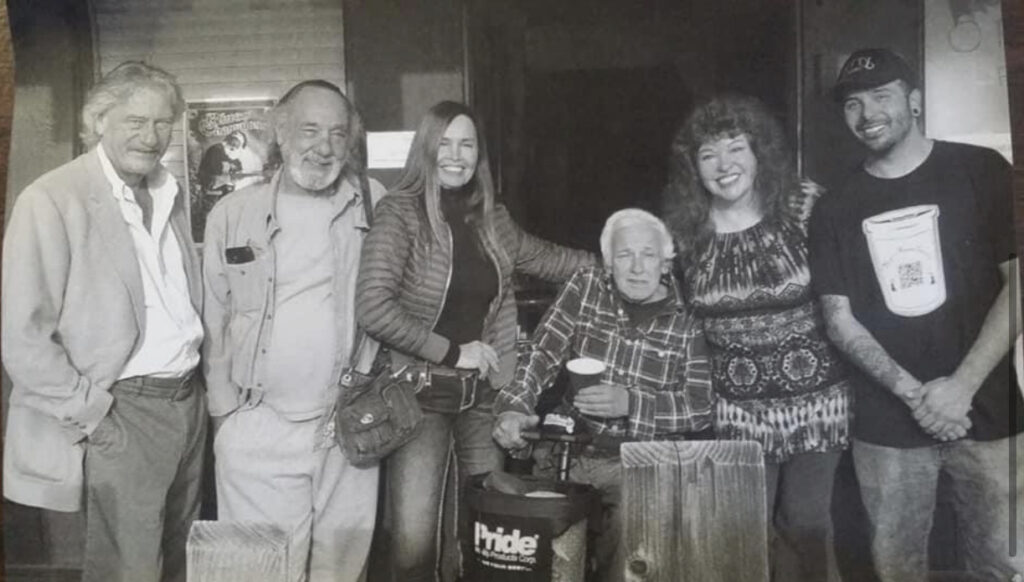
Knowing that medical marijuana had broad support in the city, the team got busy drafting the legislation that could finally put a dent in the cannabis ban. “I was on the development committee,” says Shaw. “There were 12-15 of us—lawyers, political people, activists, we all just kept working on it.” Justmann also worked on developing Prop 215, remembering the passion and clarity of vision shared by those who wrote it. “215 was something that just had to be done.”
When Justmann joined the officer corps of Peron’s grassroots organizing team, which included Entwhistle, Herer, and Brownie Mary, he was frequently interviewed by media who wanted to know his official position. The movement functioned more like Robin Hood’s band of outlaws than a formal grassroots organization, but Peron decided that if they needed Justmann to have a title he could give him one. “Dennis said, ”You are now the security director,” he recalls.
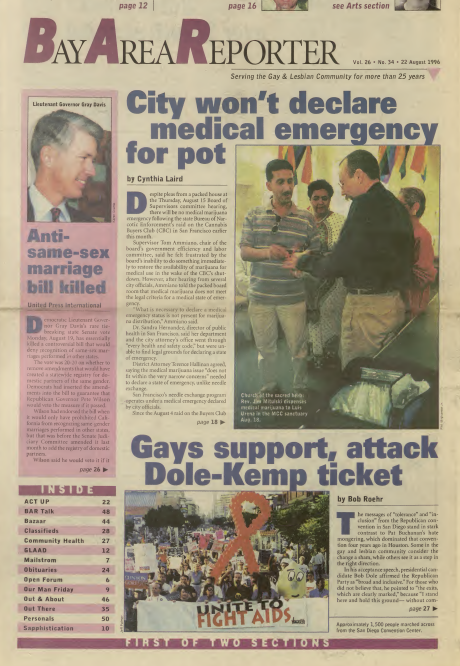
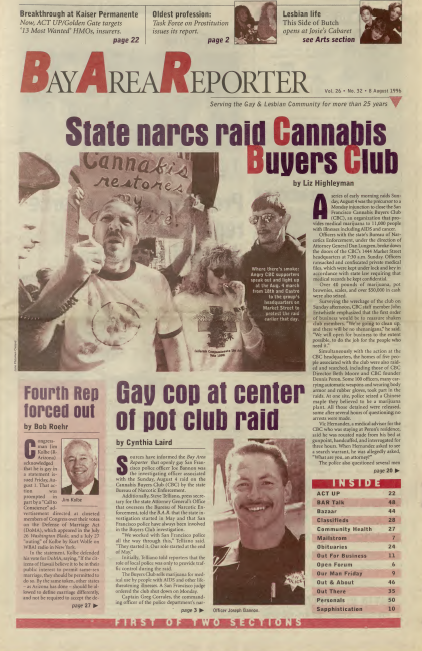
Images courtesy of the Bay Area Reporter archives
The title may have been an empty one, but the movement did need a security detail. The toxic onslaught of homophobia that AIDS advocates faced was a constant reminder that the dangers of being gay were by no means limited to the AIDS virus. While conducting their grassroots campaign to legalize cannabis for dying AIDS patients, Justmann and Peron were often greeted by hate speech, threats, and the suggestion that the virus was a well-deserved punishment for homosexuality.
Peron always understood that fighting for cannabis was a way to strike hatred with love, of which he seemed to have an endless supply. “He was someone that saw a light that many people did not see,” says Justmann when asked to describe Peron. “He was real, and he had such a huge heart. He’d listen to you.” To many, Peron’s open-heartedness seemed to permeate the walls of Cannabis Buyers Club. The atmosphere there was warm and inviting, a place where previously persecuted people could just let down their guards. “It was all about caring and sharing, there was no judgment,” says Justmann. “It’s about acceptance, respect, and love.”
Today the mission of Cannabis Buyers Club has been carried further than its members might have imagined. But even as the industry grows exponentially, there are still lessons to be learned from the old days. Dispensary owners would do well to take note of the Cannabis Buyers Club ambiance, which goes to show that a little warm lighting and funky decor never killed anyone. Growers who might be tempted to take harmful shortcuts in the cultivation process could remind themselves that this plant took care of a suffering population while the government sat on its hands, and for that, it deserves our gratitude and respect. As Pride month draws to a close, we all have an opportunity to honor those who lost their lives while the government deliberated over cannabis legalization. As Justmann says, “A lot of the people who came through there are dead. These patients are people who I sat down with, prayed with, we laughed with one another. We’ve lost so many individuals.”


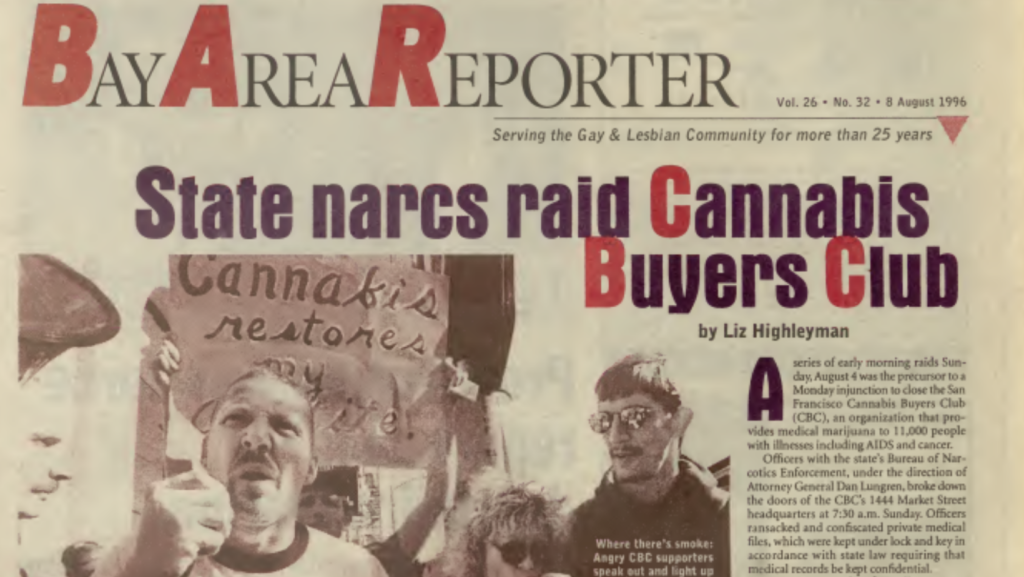

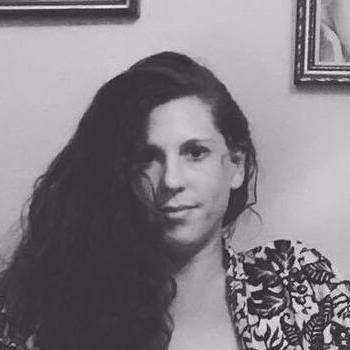

1 thought on “Love and legalization: How a gay community devastated by AIDS shaped the future of cannabis”
Pingback: With Pride month ending, here are 6 queer-led cannabis brands to support year-round - The official publication of MJ Unpacked